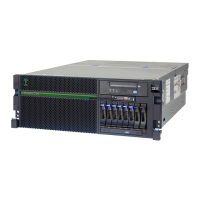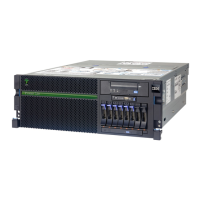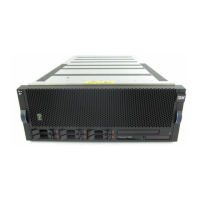SAS subsystem for the 8202-E4C, 8202-E4D, 8205-E6C, or
8205-E6D
Review the SAS subsystem features, configurations, and limitations for the IBM Power
®
720 Express
(8202-E4C or 8202-E4D) and the IBM Power 740 Express (8205-E6C or 8205-E6D) system.
What's new in SAS subsystem for the 8202-E4C, 8202-E4D, 8205-E6C,
or 8205-E6D
Read about new or significantly changed information in SAS subsystem for the 8202-E4C, 8202-E4D,
8205-E6C, or 8205-E6D since the previous update of this topic collection.
March 2013
The following updates are made to the content:
v Added information for the IBM Power 720 Express (8202-E4D) and the IBM Power 740 Express
(8205-E6D) servers.
SAS architecture
Serial-attached SCSI (SAS) architecture describes a serial device interconnection and transportation
protocol that defines the rules for information exchange between devices.
SAS is an evolution of the parallel SCSI device interface into a serial point-to-point interface. SAS
physical links are a set of four wires used as two differential signal pairs. One differential signal transmits
in one direction, while the other differential signal transmits in the opposite direction. Data can be
transmitted in both directions simultaneously. Physical links are contained in SAS ports, which contain
one or more physical links. A port is a wide port if there are more than one physical link in the port. If
there is only one physical link in the port, it is a narrow port. A port is identified by a unique SAS
worldwide name (also called SAS address).
A SAS adapter contains one or more SAS ports. A path is a logical point-to-point link between a SAS
initiator port in the adapter and a SAS target port in the I/O device (for example, a disk). A connection is
a temporary association between an adapter and an I/O device through a path. A connection enables
communication to a device. The adapter can communicate to the I/O device over this connection by
using either the SCSI command set or the Advanced Technology Attachment (ATA) and Advanced
technology Attachment Packet Interface (ATAPI) command set depending on the device type.
A SAS expander enables connections between an adapter port and multiple I/O device ports by routing
connections between the expander ports. Only a single connection through an expander can exist at any
given time. Using expanders creates more nodes in the path from the adapter to the I/O device. If an I/O
device supports multiple ports, more than one path to the device can exist when there are expander
devices included in the path.
A SAS fabric refers to the summation of all paths between all SAS adapter ports and all I/O device ports
in the SAS subsystem including cables, enclosures, and expanders.
SAS subsystem overview for the 8202-E4C, 8202-E4D, 8205-E6C, or
8205-E6D
Review the SAS subsystem features and locations for the 8202-E4C, 8202-E4D, 8205-E6C, or 8205-E6D
system.
© Copyright IBM Corp. 2011, 2019 1
